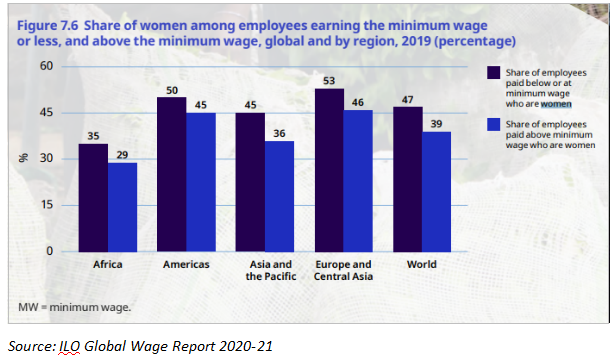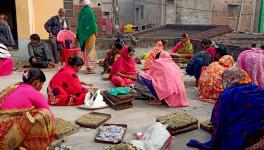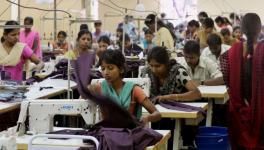Wages Fell in 2020 Due to Covid Crisis; Women, Low-paid Workers Hit Hardest: ILO Report

Image Courtesy: Wikimedia Commons
Monthly wages fell or grew more slowly in the first six months of 2020, as a result of the COVID-19 pandemic, in two-thirds of countries for which official data was available, wherein women and low-paid workers have been disproportionately affected, according to the latest report of the International Labour Organization (ILO).
The ILO’s Global Wage Report 2020-21, published on Thursday, has estimated that the equivalent of 345 million full-time jobs were lost in the third quarter of 2020.
Suggesting that the crisis is likely to inflict massive downward pressure on wages in the near future, the report underlined that the pandemic has already put enormous strain on public health service employees, a majority of whom are women. In the four years preceding the pandemic, global real wage growth fluctuated between 1.6 and 2.2%.
While the impact on workers’ incomes has been huge and poverty has become worse, the crisis has more adversely affected groups in vulnerable situations. The ILO estimated that in the first month of the pandemic, the overall earnings of informal workers globally may have declined by up to 60%.
This drop earnings has spiked the numbers of working poor across the world. The ILO report estimated that globally, relative poverty among workers in the informal economy may have jumped from 26% to 59% over the first month of lockdown. Besides, World Bank projections suggest the ongoing crisis could undo progress made in poverty reduction by pushing between 71 million and 100 million people into extreme poverty this year and thus, increase the global extreme poverty rate for the first time since 1998.
Early data from national statistical offices show that around two thirds of countries (with availability of short-term statistics) showed decreasing wages or slower average wage growth. However, in other countries, average wages showed an upturn reflecting a “composition effect” due to the loss of lower-paying jobs. The “composition effect” was seen in Brazil, Canada, France, Italy, Norway and the US, where average wages have been rising markedly at the same time as unprecedented job losses.
Vulnerable worker groups, such as migrant workers (164 million worldwide) have been among the hardest hit, the report found. Moreover, young people have suffered disproportionately as 40% of them were working in the hardest-hit sectors and 77 % were in informal jobs.
Women workers have also bore the brunt. “The impacts of the crisis have fallen differently on men and women, the latter being disproportionately affected in many ways which could widen gender gaps in the labour market and possibly wipe out the progress made over the past few years,” the report said.
Impact on Women
Women workers are one of the worst hit groups because they constitute a higher proportion in essential services and front-line occupations than men. Women account for over 70% of all health and social workers.
Further, larger proportions of women also work in the hardest-hit sectors and thereby, they have experienced greater job losses, show the recent employment statistics from countries like Australia, Canada, Colombia, Japan, the Republic of Korea and the United States.
The sectors hardest hit by the lockdowns include wholesale and retail trade, accommodation and food services, and other sectors where women workers tend to be over-represented. “It has been estimated that the hardest-hit sectors account for 40% of all female employment, compared to 36.6% for men,” the report stated.
ILO found that domestic workers have been significantly affected by job losses or reductions in working hours and earnings as well. About two thirds of 55 million domestic workers are also women. Additionally, women rely more than men on informal employment in more than 90 % of sub-Saharan African countries, 89 % of countries in South Asia and almost 75% of Latin American countries.
Estimates based on a sample of 28 European countries show that without wage subsidies, women would have lost 8.1% of their wages in the second quarter of 2020, compared to 5.4% for men. “Women’s proportion of the wage bill has been hit more severely by the unprecedented job losses and the reduction in working hours that have occurred as a result of the COVID-19 crisis,” the report said.
Added to these, women have also been subjected to unequal sharing of household work along with increased child-care work during the pandemic and lockdown.
Low-paid workers
The crisis also disproportionately affected lower-paid workers leading to an increase in wage inequalities. Citing studies, the report said that in many countries, reductions in work hours have impacted lower-skilled occupations, especially those in elementary work, more than higher-paying managerial and professional jobs.
“While average wages in one-third of the countries that provided data appeared to increase, this was largely as a result of substantial numbers of lower-paid workers losing their jobs and therefore skewing the average, since they were no longer included in the data for wage-earners,” the report said. It added that in countries where strong measures were taken to preserve employment, the effects of the crisis were primarily manifested through fall in wages.
Moreover, for selected European countries, the report estimated that without wage subsidies, workers would have lost 6.5% of their total wage bill between the first and second quarters of 2020. However, without wage subsidies, the lowest-paid 50% of workers would have lost a whopping 17.3% of their wages.
Women are generally over-represented among low paid workers and existing literature suggests that minimum wages can narrow the gender pay gaps. In all regions studied, the proportion of women among those earning the minimum wage or less is larger than their share among those earning above minimum wage.
The report found that women, young workers, workers with lower education, rural workers, and workers with dependent children are all over-represented in the group of minimum and sub-minimum wage earners. “These are some of the groups most vulnerable to the current labour market crisis and minimum wages should play a vital role in enabling them to weather such difficult times,” the detailed report recommended.

Minimum Wage and Informality
Globally, 327 million wage earners, accounting for 19% of all wage earners, are paid at or below the applicable hourly minimum wage. Of them, 152 million (46.4%) wage earners are women. It appears through absolute numbers that more men than women earn minimum wages or less. However, women are over-represented among this low-paid category of workers. Women make up only 39% of the world’s employees paid above the minimum wage, but they constitute 47% of the world’s sub-minimum and minimum wage earners.
In the world, Asia and the Pacific has the largest number of employees (160 million) earning the minimum and sub-minimum wage. This includes 72 million women.
Explaining that minimum wage can be an effective tool to protect workers from unduly low wages and decrease inequality, the report pointed out that currently 90% of ILO Member States have minimum wage policies in place. However, 266 million wage earners are still
paid less than the minimum wage, either because they are not legally covered or because of non-compliance.
Most of the workers receiving less than the minimum wage are situated in informal economies where they are mostly not protected by legal and regulatory frameworks, including minimum wage.
“High rates of informal employment undermine the role of minimum wages in protecting women against gender-based wage discrimination. Informal wage workers, particularly women, earn on average substantially less than formally employed workers,” the report stated.
In the case of India’s informal economy, where around 80-90% workers are engaged, they have experienced a much sharper fall in wages of 22.6% compared to formal workers’ who have faced a drop of 3.6% in wages, the report said citing studies.
Get the latest reports & analysis with people's perspective on Protests, movements & deep analytical videos, discussions of the current affairs in your Telegram app. Subscribe to NewsClick's Telegram channel & get Real-Time updates on stories, as they get published on our website.
























